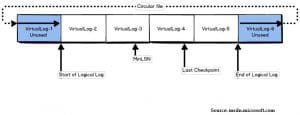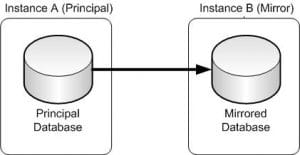In this article we look at the key functions of transaction logs in SQL Server
 Transaction Log, as the name suggests, keeps a log of all the transactions that are taking place; along with the database modifications it’s making each day. It is one of the most crucial element in your database, in case of any system failure it brings back database to a consistent condition. You should never opt for deleting or moving your transactions log unless you are not completely sure of its consequences. Following are the functions of Transaction Log:
Transaction Log, as the name suggests, keeps a log of all the transactions that are taking place; along with the database modifications it’s making each day. It is one of the most crucial element in your database, in case of any system failure it brings back database to a consistent condition. You should never opt for deleting or moving your transactions log unless you are not completely sure of its consequences. Following are the functions of Transaction Log:
- Recovering Individual Transactions: In-case of an error in the Database Engine such as loss of communication with a client or issuing a ROLLBACK statement, log records rollback the modifications done during an incomplete transaction.
- Recovering Incomplete Transactions as SQL Server begins: In-case of a failure in the server running the SQL Server, some of the transactions are left incomplete. These transactions and their modifications are rolled back when a SQL Server instance begins; this is done to ensure integrity of databases.
- Restoration up to the Point Of Failure: You can restore a database to the point of failure; first restore full database backup, then differential database backup and then the leftover transaction log backup up to the point of failure. After restoring each log backup, Database Engine will apply the necessary changes recorded in the log file and thereafter roll forward all transactions.
- Supporting Transactional Replication: Transaction log of every database is monitored by Log Reader Agent for the purpose of transactional replication.

- Log Shipping and Database Mirroring: Both of these processes rely predominantly on Transaction log. In Log Shipping the active transaction log file of the primary database is sent to multiple destinations by the primary server. In Database Mirroring, principal server instance is used for sending all log records instantly to the mirror server instance.
After knowing the functions of Transaction log, it is also important to know what are the characteristics of the transaction log, in order to understand the concept better. Listed below are the characteristics of transaction log in SQL Server Database Engine.
- It is implemented in isolation with other files; as a single file or as a set of files. The cache from transaction log is handled separately and not with the buffer cache used for data pages.
- The log records and the pages can have a format different from the format of the data pages.
- It can be implemented in multiple files; there is scope for expanding files automatically by placing the FILEGROWTH value for the stored log. This can help reduce the shortage of space in log and also reducing administrative overhead simultaneously.
- The mechanism which exists for recycling the existing space in transaction log provides quick results along with causing minimum impact on transaction throughput.
The transaction log helps to easily track transactions and keep a record of all modifications caused by those transactions.
SQL Errors are Typically Encountered in Any Implementation and should Not be Ignored
Most SQL users would agree that SQL errors are commonly noticed and are typically not given much value by administrators. However errors related SQL data file should not be ignored as they may be precursor to a SQL crash. In case you suspect a SQL file to have become corrupted you can use an mdf repair tool like DataNumen SQL Recovery to extract its content and save it into a new MDF file. This remarkable tool has the capacity to perform a complete recovery of all stored records with missing anything including indexes. Further, if needed, the tool can be used to save the extracted content in text file too.
Author Introduction:
Alan Chen is President & Chairman of DataNumen, Inc., which is the world leader in data recovery technologies, including access recovery and sql recovery software products. For more information visit www.datanumen.com